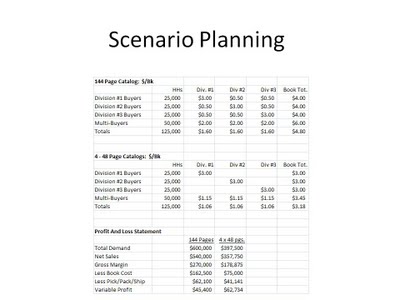Dear Catalog CEOs: Much Smaller Catalogs
 Dear Catalog CEOs,
Dear Catalog CEOs,Some of you ask me to do a unique analysis, one I call a "filtering" analysis.
Others might refer to this analysis "segmentation" or "persona development". The objective, honestly, is the same.
And for catalogers, it has never been more important.
I'm not talking about traditional RFM segmentation. Instead, I am talking about creating a series of "strategic segments", segments with unique characteristics.
In the example I have here (click to enlarge the image), there are three merchandise divisions. This catalog company sends a 144 page catalog to each customer, with equal page counts attributed to each merchandise division. In this case, about 60% of the customer file only buys from one merchandise division.
So instead of sending a 144 page general merchandise catalog, let's create four small versions. Each version has 48 pages instead of 144. Version #1 only has merchandise from division #1. Version #2 only has merchandise from division #2. Version #3 only has merchandise from division #3. Version #4 is small, and has a sampling of each merchandise division for customers who buy from multiple merchandise divisions.
We target each smaller version to the audience that enjoys it. Your job is to create each 48 page version just like you normally would.
Take a look at the profit and loss statement in the image above. Clearly, customers spend less because they are receiving fewer pages. But even if the smaller catalogs cost $0.60 each (vs. $1.30 each for a large catalog in the example), it is more profitable to send the four smaller versions, one version per customer, than to send the general catalog to each customer.
Honestly, it is easier to send the general catalog to each customer. It will always be easier. The inertia within your organization will demand the easier solution.
But we're in a position where profit dollars are what are needed, right?
So when you're looking for new strategies for the second half of 2010, give this strategy a try, as a test, and see what happens!
Thanks,
Kevin
Labels: Dear Catalog CEOs
3 Comments:
Kevin, we have tried this several times in Germany in the B2B. Every time, the initial metrics were like you stated. In the long term however the average order value and the sales per customer per year reclined much more than could be compensated by less catalog costs. Maybe a matter of "competence" in merchandise. One cataloger stated that big books yield big budgets with the customer. They even tried to acquire new customers with small books and upsell the respondents with big catalogs. But the customers AOV remained at the level of the first catalog impression, i.e. a small one.
I can't say the same holds true for B2C. What the big book-cataloger always worry about is the Sears example. Splitting the big book in smaller ones and loosing your shirt...
Well, that's why we recommend testing the strategy, right? Every company and every geography have unique customers with unique characteristics.
Some of this has to do with the evolution of the customer. What you describe is exactly what I saw at Lands' End and Eddie Bauer in the 1990s. You can correlate telephone sales with this phenomenon. When telephone sales do not contribute much to total sales, then catalogs can get smaller. Watch ratios between telephone sales and online sales --- this sometimes dictates how small catalogs can get.
Thanks for the idea of the ratio between telphone sales and online sales. I guess this is because customers more and more discover the online-offering and thus remain active without the BIG catalog. Catalogers can tease them to go to the website instead of doing all the sale-through via the catalog?
Post a Comment
Links to this post:
Create a Link
<< Home